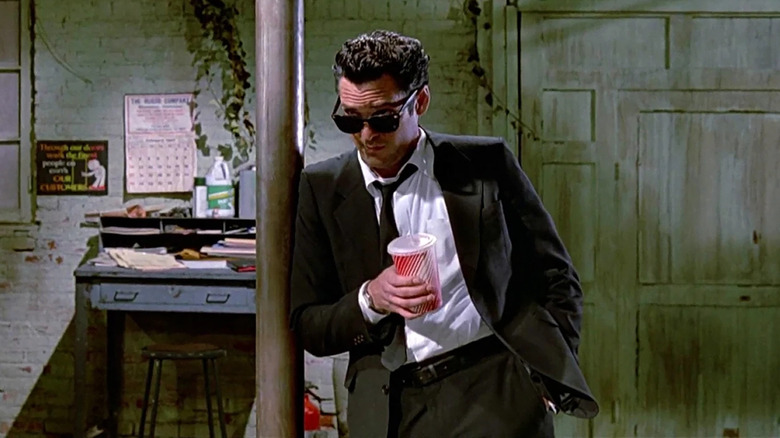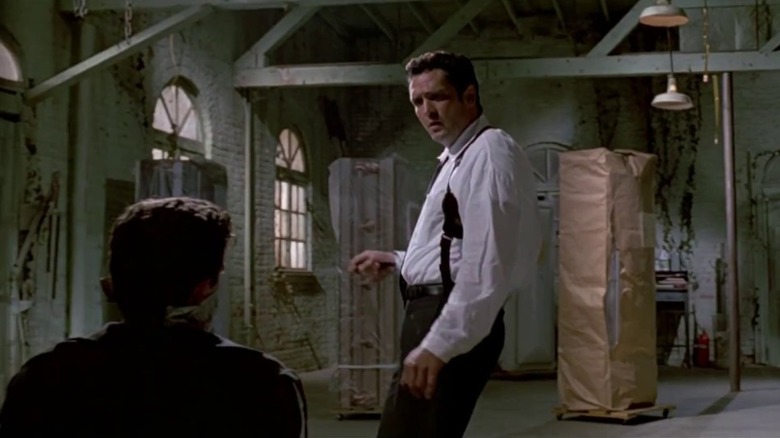The Most Legendary Michael Madsen Scene Is Still Terrifying Decades Later
When Quentin Tarantino emerged on the scene with "Reservoir Dogs" in 1992, he proudly wore his influences on his sleeve. Tarantino is as much of a student of the screen as he is a creator of movies for it, marrying the cinematic language of the violence in exploitation and martial arts films with the character-driven writing of high-art, American auteurism. All of the trademarks of Tarantino's filmography were on display in his debut feature, like eclectic soundtracks, non-linear storytelling, and buckets of blood. Even before the film was released, Hollywood legends like Don Coscarelli were baffled by the brilliance on display from a first-time filmmaker.
Tarantino had made a crime thriller, but instead of it being about a group brought together to carry out the crime in the climax, it focused on the aftermath when six individuals operating under pseudonyms — Mr. White (Harvey Keitel), Mr. Orange (Tim Roth), Mr. Blonde (Michael Madsen), Mr. Pink (Steve Buscemi), Mr. Blue (Edward Bunker), and Mr. Brown (Tarantino himself) — try to figure out who set them up after the police ambush their robbery.
As the audience, we learn so much about these six men by watching how they react to this paranoid, intense situation, and it's clear almost immediately that Mr. Blonde is dangerously unhinged. So by the time he has a police officer tied up and begins to torture him for the fun of it, we're already on high alert. We know that he's capable of just about anything, but the fear lies not in graphic imagery, but the bemused acceptance that Mr. Blonde is going to cut off a man's ear without ever elevating his heart rate, all set to the tune of Stealers Wheel's 1972 song "Stuck in the Middle with You."
Michael Madsen played Reservoir Dogs' ear scene to perfection
The terrifying effectiveness of the scene lies in the delightful way Madsen dances around the room while preparing to slice off the ear of Officer Marvin Nash, played fantastically by frequent Tarantino collaborator Kirk Baltz. The eerie calm with which he moves contrasts sharply with the barbarity he's about to unleash. Every second only amplifies the jarring dissonance on display, which Tarantino gleefully weaponizes against the audience.
The upbeat song paired with sadistic violence taps into something deeply unsettling. It's not just what's happening, it's how it's happening, and Tarantino smartly pushes our imaginations into overdrive by pulling the camera away from Mr. Blonde while he slices off the ear. We don't see the special effects that fill in the blanks, and are forced to visualize it for ourselves. He makes us an active participant in the torture, a decision that even disturbed horror legends like Wes Craven and Rick Baker.
Thematically, "Reservoir Dogs" is an examination of the illusion of control and the performative nature of masculinity, both of which are well on display in Madsen's performance. There's something so chillingly casual about how he approaches his butchering. His relaxed strut looks more like a dad at a wedding reception than a cold-blooded criminal, keeping the film so grounded in reality that viewers struggle to put up the safe distance wall of "this isn't real," as provided by horror movies. Tarantino took the repulsiveness of the "Singin' in the Rain" sequence from "A Clockwork Orange" and gave it a mean streak for the 1990s. In turn, Mr. Blonde laid the groundwork for Patrick Bateman in "American Psycho," and now viewers know to never trust a happy song if it's the soundtrack for a man with a blade in his hand.

